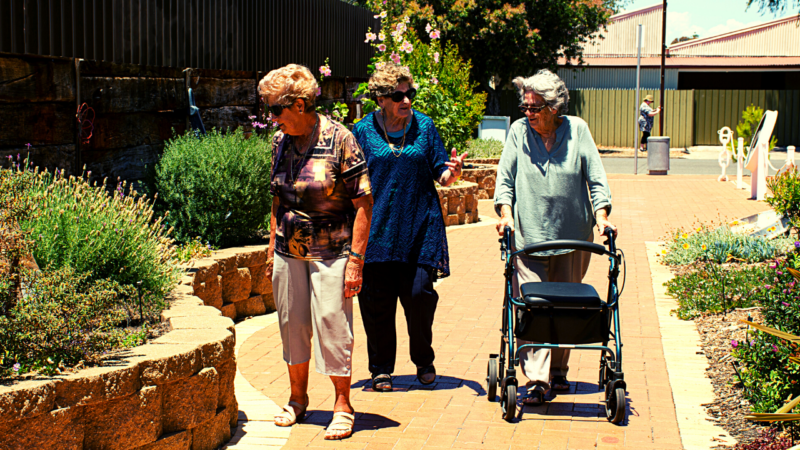The Physio Co team recently heard from sports science expert Professor Peter Reaburn how to help seniors maintain a fulfilling lifestyle, writes TPC founder and CEO Tristan White
If we stay active in our senior years, it follows that our enjoyment of life is better. Using exercise to remain mobile helps maintain our lifestyle, and there are proven links between physical and mental health.
You don’t need to be an ex-Olympian or a super-fit senior competing in Masters events to appreciate those lessons – we can all learn from how those used to sporting excellence manage the inevitable decline in physical powers.
At The Physio Co, we like to glean knowledge from all quarters, so we recently welcomed Professor Peter Reaburn, former Head of Exercise and Sports Science at Queensland’s Bond University, for a workshop that included valuable lessons about the importance of maintaining mobility.
Peter retains a lifelong passion for competitive sport, and his own achievements in older-aged sport are impressive: as a Masters athlete he won the National Ironman Triathlon Championship (50-54 years) in 2005, and in 2018 won the 60-69 years division in the 2.8km Big Swim at Sydney’s Whale Beach.
Firstly, some cold, hard facts about our physical performance and ageing – and how you interpret these probably depends whether you’re a glass half-full or glass half-empty person.
Peter says:
“When we talk physical performance, when we talk fitness, when we talk mobility, I would consider three major factors that do deteriorate. And interestingly, they tend to decline linearly till around 50 years, then start to get worse until around 65 and then exponentially get worse.
“Probably in priority order, cardiovascular fitness decreases linearly from around 30 to 35 years of age. Older athletes who are triathletes decline more slowly than a non-athlete, but they will still decline. Around 65 to 70 years of age, cardiovascular fitness really starts to slide and I must admit, I’m starting to experience that myself now I’m 67.
“The second major factor is muscle mass, which is correlated with strength. And the third decline is inflexibility – range of motion around a joint.
“Combine those – the strength factors and the muscle mass, with flexibility – and you’re really impacting on mobility.”

That mobility factor extends to getting out of a chair, getting out of bed or taking the rubbish out – in other words, daily life.
Do you admit defeat? Or focus on reducing those declines and working hard to keep as fit and mobile as possible for the important things in your life – whether that’s competing in ocean swims or getting to see family and friends?
I’d choose the latter option – and it’s here that Peter shows how the thinking of elite sport can influence and inspire our way of looking at it.
While we won’t all turn into marathon runners overnight, there is some wisdom in pushing your boundaries in exercise to keep yourself more mobile in everyday life.
As Peter told our physios:
“Go by the books and use the science, but also encourage and maybe even nudge your older clients into having a crack and doing some more physical activity, or something different that might be a bit harder than they have done in the past.”
Statistics show that many people need encouragement to meet minimum recommended exercise levels, with most older Australians exercising only once a week. By exercising twice a week you’ll maintain fitness, and three times a week will improve strength, cardiovascular fitness and flexibility.
Peter says: “Very few older people are meeting the physical activity guidelines that the World Health Organisation (WHO) is putting out, that the Australian Government is putting out. It’s quite scary how few 65 and older people are meeting those guidelines. Around 16% are meeting the guidelines – so we are saying 84% are not meeting the guidelines.”
WHO guidelines suggest 150 to 300 minutes of moderate exercise a week, which could be broken into a 15-minute morning, 15-minute afternoon routine, five times a week to achieve the minimum.
The key is to make sure you’re both challenged enough to get results but exercising safely. That could be walking, swimming, using a gym or at home doing a circuit up and down some stairs.
Peter focused on the older athlete for his PhD thesis (and in five books he’s written or edited) and endorses The Physio Co’s aim of using physiotherapy to improve the lives of senior Australians.
Peter says: “I applaud keeping older people more mobile in a safe environment, and happy and enjoying what they’re doing.”
As important as frequency is intensity – in other words, don’t overdo it too early, but build up to your ideal workload. Too much too soon and you could get injured or be sore for days.
Peter says: “The key for older people is to gradually increase intensity, work on frequency first, time spent exercising second, and intensity last – get their bodies accustomed to it before you start ramping up the intensity.”
Regular exercise and pushing boundaries within safe limits – that’s the key. I’m a comparative youngster at 42, but I get reminded of my limits if I don’t exercise regularly. I think that I’m fitter than I am, then I push myself a bit too hard and get sore, then need a few days off.
The last word goes to Peter: “One approach to physiotherapy for older people is all about maintenance and we want to challenge that. Of course, we want to maintain the level that we’ve got, but why not be bold enough to consider what’s possible, and where we could go to with the health and fitness, and mobility of older people.”
- Professor Peter Reaburn is a “pretty fit 67-year-old” who has been very active all his life and practises what he preaches. He still enjoys sport in all its forms, from watching footy on television to swimming competitively. He has a PhD in exercise physiology, still works at Bond University as an honorary professor, walks most days and “I still enjoy surfing at my age. Love it.” When getting up on his board became harder than it once was, he started racking up the burpees at the gym to counter this decline.
- This article is based on a presentation Professor Peter Reaburn gave to The Physio Co’s in-house event – TPC SWARM.

 1300 797 793
1300 797 793
